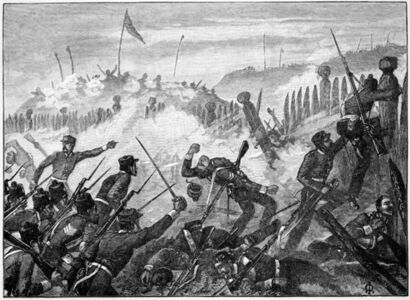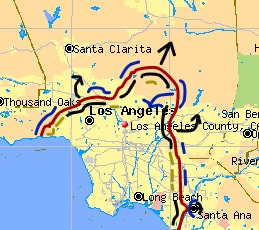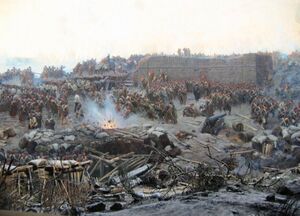The First Border War
The reason given is:
Last edit by: Finium (talk · contrib) · Last edited on Mon, 03 Feb 2020 21:43:41 +0000
The First Border War (FBW) was the first war of the Socialist Random Empire's expansion, along with the Second, Third, and Fourth Border Wars, commonly known as The Border Wars. The FBW lasted from 1895-1896, and had the United States and the SRE fight for dominance of Los Angeles. Over 1,200 soldiers died, however, no civilians died as a result of the conflict. Los Angeles County was disputed between the SRE and America. In September of 1895, U.S State Troops began to open fire on SRE soldiers stationed there, and members from communist rebellions. This skirmish enraged the SRE, and they declared war on the U.S. The Soldiers already stationed in the city, pushed the troops out to the Sierra Nevada Mountains. Communist began to actively rebel across L.A. Local reserves were called upon, and they pushed the SRE back to the city. Winter came, and the SRE dug in and fortified L.A. In April, the U.S and SRE fought in the Battle of L.A, where 500 people died. The Socialist Random Empire sent more troops in L.A. The U.S raided San Diego in April. Then sent an ultimatum to Charles that if he doesn't release L.A, the U.S would attack Ensenada. Charles responded by threatening to get The Socialist America, a large communist group in that controlled most of L.A country, involved in the War. The U.S, figuring it was too much to fight a full blown war for a city that doesn't want to be a part of the nation, gave Los Angeles on June 3, 1896.
Prelude
After the Socialist Random Empire gained it's independence from Mexico, it had territory disputes with the United States of America. The SRE claimed control over San Diego and Los Angeles. In July of 1893, both nations signed the Treaty of San Diego, handing over San Diego to the SRE. That left Los Angeles as the only disputed territory. Riots between communists and federalist civilians broke out over who controlled the city. In response, both nations sent in police forces to stop the riots. In October, the SRE began to "rebuild" L.A as a part of its rebuilding campaign. In 1894, the SRE started to tax L.A. This act enraged the U.S.A, who put sanctions on the SRE.
Tension was building, California State Guards began to patrol the county. In response, the SRE sent a expeditionary force to protect the city. By this time, most citizens of L.A were pro-SRE. In October, they elected a socialist leader, who stated that Los Angeles was not a part of the U.S. He ordered that flags, symbols, currency, and names were in line with the SRE. This enraged the U.S, which started to send State Guards into Los Angeles city. Socialist groups began to spring up, actively opposing American police. The police started to fight these groups. In late September, some infantry from Fort.Angeles were patrolling the fort, when they saw some action between police and socialist. The soldiers tried to intervene, but the State Guard mistook them for more Socialist, and they fired upon them. These actions enraged the SRE, and on October 10, 1895, they declared war on the United States.
Opening Action
Push to the Sierra Nevada
General Moroando ordered his troops to leave Fort.Diego, and push to the Sierra Nevada Mountain. In October 11, 500 Random soldiers began to push out the fort, and into the city. State guard and police men tried to hold back, but their forces weren't enough. Socialists began to help the Randomians, with some forming militias, others burning American buildings. On the 13th, some State Troops, Los Angeles Police, and Loyalists led by Captain Keys planned a counter attack on Sunset Blvd. The small skirmish killed 7, 3 Americans, and 4 Randomians. Still, the SRE kept pushing. On October 16th, the U.S ordered a retreat.
On October 18th, the SRE started to push out of Los Angeles. They met little resistance at first, but as more got alerted to this news, loyalist militia began to spring up. The advance started to slow, but communist insurgents helped the SRE move westward. Most of the forces were defeated by the 25th, and troops began to quickly move. Captain James Keys of the National Guard assembled a team of 80 men to storm a weak point in the salient. However, their plans were found out by insurgents, and the SRE engaged the American forces. This caused 22 to die, mostly Americans. Western forces began to move out of L.A. Meanwhile Eastern Forces were moving into Orange County, and trying to capture Santa Ana.
The entire L.A coastline was captured on October 26th. On the 27th, the bulge began to spread out as Western and Eastern forces moved North. With a united front, the SRE pushed northeasterly. The Americans had little forces to stop the nearly 1500 SRE soldiers and communist Militia. On the 30th, the advance began to slow, as the SRE began to fight on steeper terrain. This did not stop the Randomians, and by November 1st, they had reached the eastern edge of the Sierra Nevadas. The SRE stopped, as they were not equipped to fight on arid terrain.
United States Counter Attack
Socialist groups surged as the SRE began to move out of L.A. Notifying American Forces to the SRE threat. Then Captain James's regiment retreated from L.A and notified the 16th Infantry Regiment. Colonel Buck Jackson organized a counter attack. He had 1700 men to fight against the SRE, along with the national guard. Jackson tried to get more forces, but they were the only one in the area, and he did not want to risk the SRE, pushing them even farther from L.A. Their plan was to push across the Sierra Nevada, and try reach L.A before winter came.
On November 3rd, the U.S fought back. American soldiers took out the many outposts in the mountains with relatively little resistance. The socialist militia in the area also did not provide that much support, as they were poorly armed and untrained, By the 6th, the U.S had pushed the SRE 15km back towards Los Angeles. Down east, the SRE had been pushed out of Santa Ana by National Guard and loyalists. In the west, Thousand Oaks was put back into U.S control. All of the events occurring on November 9th. On the 11th, only the city of Los Angeles, Long Beach, and their surrounding areas remained in the SRE's hands.
The 1st Brigade under Fred Holstein tried to take Long Beach on November 12th. 160 men gathered outside the small city, the SRE with only 50 soldiers were outnumbered. The soldiers took defensive positions in the buildings of the city, and both sides started to open fire on each other. The Randomians were losing the battle at this point, with 10 deaths. But around noon, the soldiers got help from local insurgents. Around 100 socialists were entered the battle from the east. The Americans were shocked, and had to focus its forces on two sides. A retreat was ordered by Major Holstein, and Long Beach was secured.
Winter Events
As November became December, and the temperature dropped, fighting began to stop. The SRE began to fortify the city. They used up their supply of guns, ammounition, stone and wood. In January, a freighter gave them more supplies for the fortifications. The freighter also gave the SRE food, which gave L.A around 6 more months of food. More soldiers were also being recruited into the defense; and civilians began to train themselves for the defense. Most loyalist left at this time, and joined the American force.
There were few skirmishes during December and early March. Most skirmishes were small, they had 3-4 men on each side, and resulted in few deaths. One skirmish in late January was especially large, however. A dozen soldiers from both sides fell, as two squads of Random and American soldiers battled.
Battle of Los Angeles
In March, the war began to resume. Skirmishes were becoming more frequent. The U.S were planning an offensive to take L.A and end the War. Jackson assembled a force of 1900, along with some cannons and artillery, to storm the city, and take back Los Angeles. In March, socialist scouts spotted the force, but they were destroyed by the Americans. This left the SRE clueless to the attack. The SRE were still expecting a large attack, however, they didn’t expect this scale. Machine guns were added to the SRE’s arsenal just in time, before the invasion. This would prove vital in the upcoming battle.
On April 7th, the Battle of Los Angeles commenced. Artillery began to bombard the city. And cannons began to tear down walls. The Randomians were surprised, but quickly fought back. Machine guns began to suppress and kill incoming Americans. For the first two hours, the Randomians held back the U.S.A. But the Randimians began to understand the scale of the battle. Ammunition began to run out, and machine guns jammed often, taking minutes to repair them. Worst for the SRE, American Calvary began to enter holed in the defense, killing small pockets of militia. But they still held the defenses, even into the 10th of April. But this changed as a second major wave of American soldiers attacked Los Angeles. The defenses were crippled. What was left of the Random soldiers retreated back to the city.
In the city, fierce close quarters combat occurred. Both sides fought for streets, buildings, and rooms. 200 had died by that point. The Americans were rapidly coming in the first days of the invasion; they moved so quickly that one group of Randomians were trapped in a courtyard. They held in the area next to a statue for 15 hours under heavy fire before dying in battle. This attack boosted Random morale, and inspired L.A to fight harder. By the 17th the American advance had stopped. During this time, militia played a vital role in the battle. Providing information by scouting the Americans and providing support in combat.
The third offensive on April 19th, 1896, was a SRE victory. The SRE was running out of supplies, specifically ammo. A freighter with the materials was inbound towards the city. Cannons from the U.S opened fire on an incoming freighter, destroying it. But the SRE were able to recover some of crates, and they were able to arm themselves. The Americans did not notice this, and they attacked the Randomians. The SRE held back, stopping the advance. Civilians were also armed, they helped hold the city, as Americans began to launch the advance. This day was the bloodiest for the U.S, as 160 died in the battle.
Proving their willingness to defend Los Angeles, the Americans stopped attacking Los Angeles for a week. Meanwhile, the Socialist Random Empire began to repair their part of the city, as they were expecting another attack.
Raid of San Diego
The U.S also started to attack different parts of the SRE. Some pushed a few kilometers into Baja California. Some attacked in between L.A and San Diego. But some national guard, and militia pushed into San Diego itself. They intended to cause a distraction to relieve pressure on L.A. They also wanted to stop troop movements to the city.
Around 200 soldiers began to march to San Diego on April 22nd. When they arrived, they began to attack the small local militia. Police officers also helped defend San Diego, but they weren’t enough. Civilians began to evacuate from the city. Up north, reserves were called upon, and they arrived on the 23rd. A brief skirmish occurred between the Randomians and the Americans. This resulted in the deaths of ~20 on both sides, and the SRE leaving San Diego. The Americans looted the city. They took, food, equipment, silver, gold, guns, ammunition, building supplies, horses, and more, they left on the 25th. The SRE returned to San Diego a week later.
End of the War
Troops from Baja California were moved to Los Angeles on April 17th, and they arrived in May. They reconnected L.A to the rest of the SRE, but this connection ended as the Americans attacked San Diego. The United Stares sent an ultimatum to Charles on May 7th. The demands goes as follows - Release Los Angeles, and leave the city. Or Ensenada will be razed. Charles Random responded back. He threatened to get The Socialist America, a large, underground socialist group, involved. This would effectively trap the U.S troops in the county.
On June 1st, the United States of America offered peace with the Socialist Random Empire. The SRE accepted this request. In the 3rd of June, 1896, the Treaty of Los Angeles was signed by both nations, ending the First Border War. This gave Los Angeles and Orange County to the SRE. After over 1300 died, the SRE got Los Angeles.
Effects of the First Border War
The First Border War was, as the name implies, the first of a series of wars that would expand the SRE. It was also the first war the SRE fought after the Random War of Independence. This war solved a sizable part of the nation’s population crisis. Los Angeles would become an economic powerhouse in the 1920’s, and be renamed Chancia Randomia in 1932, and becoming the capital of the SRE in 1937. It would also be the place of new technological, economic, and other breakthroughs for the SRE.
The United States fared less well. More socialist rebellions would appear across California, and the U.S started to lose even more control of the Southwestern Pacific. By the 1910’s, tensions began to calm down because socialists could finally move to the SRE. By the forties, the Southwest had become pro U.S again, and capitalism returned to the area after nearly 70 years of communist rule. The U.S did lose out on the economic benefits of Los Angeles, however.
The SRE gained around 5000 square miles of US territory. Relations didn’t really heal after the First Border War, and the 2000’s. Both countries rebuilt from this war effectively.
Timeline
1893
July 17: The Treaty of San Diego is signed.
August/September: Socialist and Loyalist Riots breakout.
October: Reconstruction begins.
1894
March 18: The SRE begins to tax L.A.
March 26: The U.S embargo’s the SRE.
May 11: State Guards Patrol the county.
September 23: The SRE sends the 9th Expedition Regiment.
October 16: Los Angeles elects Hughes Johnson as Mayor.
October 17: The Daily Commune is established.
November 9: The currency of L.A is changed to the Random.
November 16: American flags are changed to the SRE’s.
December 31: State Troops enter L.A.
1895
January 1: A state of crisis is declared by the SRE.
January 3: The US also declares a crisis.
February-October: Socialists begin to attack policemen.
July 5: Fort.Angeles is established.
October 8: Random troops and State troops attack each other.
October 10: The SRE declares war on the United States.
October 11: The SRE pushes out of Fort.Angeles.
October 13: Captain Keys counterattacks on Sunset Blvd.
October 16: The US retreates.
October 18: The SRE pushes out of Los Angeles.
October 23: The SRE attacks Captain Key’s force.
October 26: The L.A coastline is captured by the SRE.
October 27: Santa Ana is captured.
October 28: Thousand Oaks and Santa Clarita is captured.
November 1: The SRE reaches the eastern edge of the Sierra Nevada Mountains.
November 3: The United States fights back.
November 9: Santa Ana and Santa Clarita are recaptured.
November 11 Los Angeles and Long Beach remains in the SRE.
November 12: The Battle of Long Beach occurs.
November 30: The SRE begins to fortify the city.
December 4: The temperature reaches 0°C in the day.
1896
January 12: A freighter arrives with cargo.
January 18: A large skirmish occurs.
March: The temperature rises, and the war resumes.
April 7: The Battle of Los Angeles starts, the defenses are damaged.
April 11: The Randomian’s retreat into the city.
April 12: Close Quarters combat begins.
April 13: The Stand at Blady’s Courtyard occurs.
April 17: The advance halts. Reinforcements start to move to L.A.
April 19: The 3rd wave begins as cannons destroy a Random freighter. The SRE is able to recover the cargo, and mounts an effective defense against the Americans. It is the bloodiest day for the Americans.
April 21: The US starts to push into Baja California and in between L.A and San Diego.
April 22: The US begins to attack San Diego. Civilians evacuate the city.
April 23: The SRE fails at counterattacking, the Americans loot the city.
April 25: The U.S leaves San Diego.
April 30: The SRE returns to the city.
May 1: The Troops arrive.
May 7: The US gives an ultimatum to Charles.
May 11: Charles responds, stating that he will get The Communist America officially involved.
June 1: America sues for peace.
June 3: The Treaty of Los Angeles is signed, the First Border War had ended.




